It is incredibly easy to make prepared horseradish. This traditional recipe uses fermentation (not cooking) to create a flavor-packed jar of horseradish. It is simple and delicious!
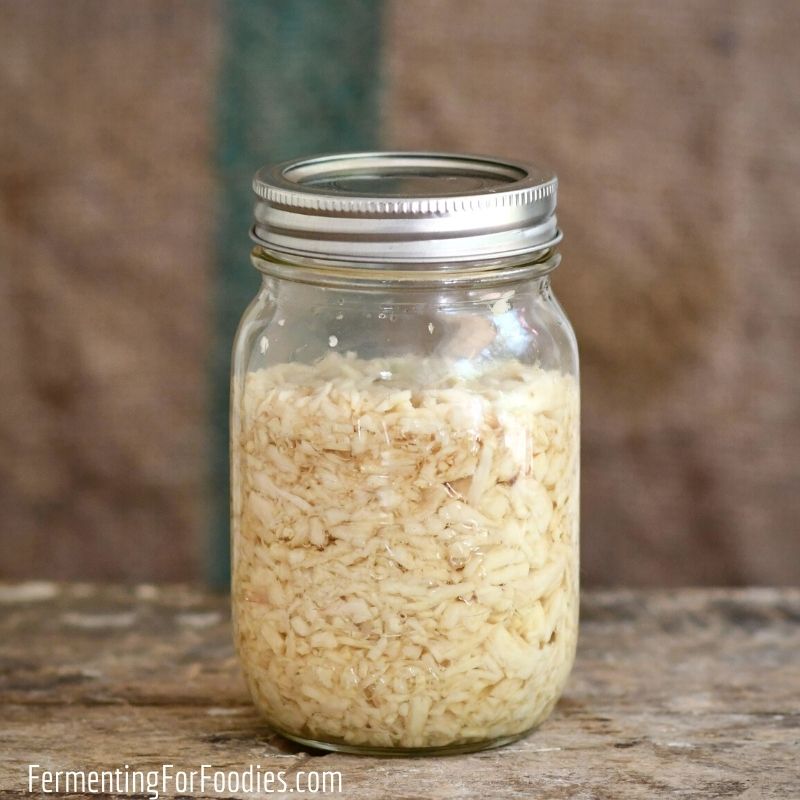
Homemade prepared horseradish has a few advantages over store-bought versions:
- It is free of sulfites and other preservatives that are typically added to keep commercial horseradish bright white.
- Very affordable. As long as you can find a chunk of horseradish root, you can make prepared horseradish.
- Zero-waste, like all fermented condiments!
The first time I tried making my own prepared horseradish sauce was by accident. I sent Brad to the store for a piece of horseradish root so that I could use it to keep my pickles crisp. (I always make a huge batch of fermented pickles in the fall, they’re just so easy).
He came home with something that was about the size of my arm. It was far more than I needed, so I consulted my herb book and discovered that preserved horseradish is a traditionally fermented recipe. So, of course, I had to make some!
How to use prepared horseradish
A spoonful of preserved horseradish is an easy way to add a burst of flavor to all sorts of dishes. Here are a few ways to enjoy your homemade prepared horseradish.
- Traditionally, horseradish is served with roast beef. However, it is also delicious with pork or fish.
- Horseradish mayonnaise is perfect for sandwiches and burgers. Mix 2 Tbsp of horseradish with 1/3 cup of mayonnaise.
- Use horseradish as a mild version of wasabi paste for sushi.
- Mix it into hummus for a bit of added zip.
- Make a carrot, apple, and horseradish salad.
- Horseradish mashed potatoes are packed full of flavor.
- It’s fine to use preserved horseradish in other pickled and fermented recipes that call for horseradish. Try my fermented pickles or zucchini relish.
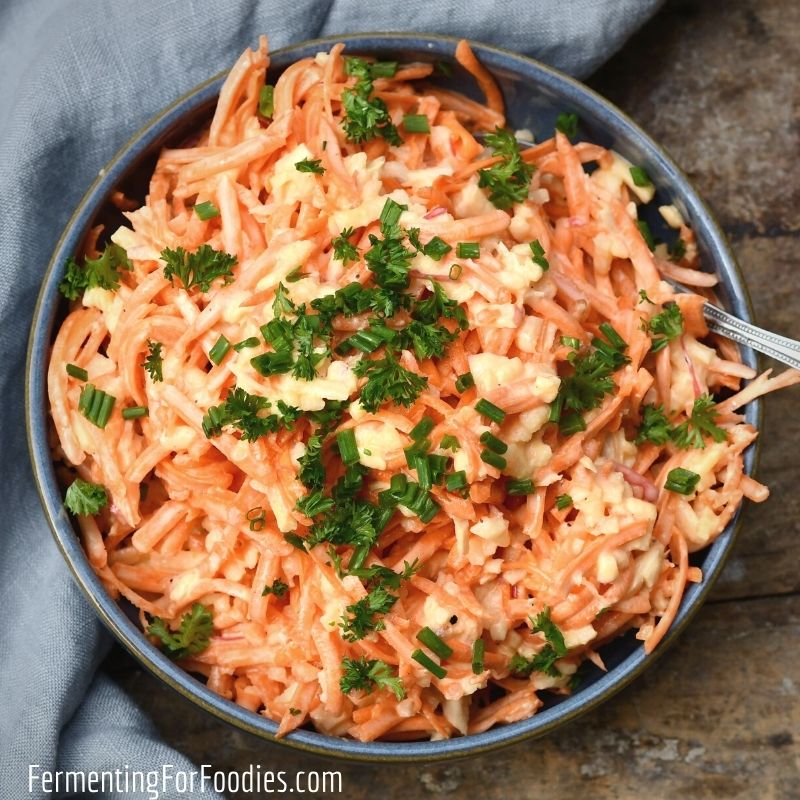
Prepared Horseradish
Homemade prepared horseradish is so easy to make. This traditional recipe is fermented and will last for months in the fridge. See the section above for six ways to serve preserved horseradish.
- Prep Time: 10 minutes
- Total Time: 10 minutes
- Yield: 2 cups 1x
- Category: Condiment
- Method: Fermented
- Cuisine: British
- Diet: Vegan
Ingredients
- 2 cups of horseradish, peeled and chopped (about 10 oz)
- 1 cup raw apple cider vinegar (with mother)
- 1/2 tsp salt (non-iodized)
Instructions
- Horseradish is quite strong, so I recommend making this recipe outside. At least for the peeling and mixing. Otherwise, you may end up in tears!
- Start by peeling the horseradish. Depending on how fresh it is, you may be able to use a peeler, but tough and gnarly horseradish root can be peeled with a knife. Rinse the root after peeling.
- Coarsely chop the root, then place the chunks in a food processor or blender. Grind until the horseradish is finely diced.
- Measure two cups of loosely packed horseradish root into a bowl. Stir in the salt.
- Pack the salted horseradish into a small jar. Pour over the cider vinegar. You need just enough to fully submerge the horseradish (3/4 cup to 1 cup).
- Place the jar in a dark cupboard and leave it to ferment for at least 5 days and up to 4 weeks.
- After fermenting, cap with an air-tight lid and store in the refrigerator. Use within 6 months
Notes
- Store-bought horseradish is high in added sulfites, which is why it stays white. Your horseradish will turn slightly brown over time. It should last for up to 6 months in the fridge as long as you don’t double-dip.
- I find it handy to ferment in the final serving jar. This recipe will fit in one 500mL mason jar or two 1 cup mason jars.
- To ferment the horseradish, it is important to use raw cider vinegar with a mother. If you can’t find raw ACV, then simply skip the fermentation step and place the horseradish directly in the fridge. It will end up being vinegar pickled rather than fermented.
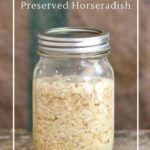
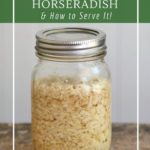
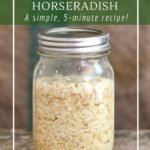
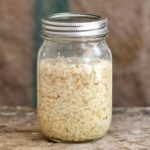
Hi Emillie!
My first time fermenting. I have a perfect amount of horseradish root for this recipe. Do I leave the lid off the top of the jar while on my counter top? Cover with a clean kitchen towel? I was thinking yes because of pressure with lid on tight. Just wanted to clarify.
Thanks,Amy
Either use a loose fitting lid (putting the metal jar lid on without the ring is perfect) or cover with a tea towel. Good luck with your first ferment!
I have just bought some horseradish, pricey here in southern part of Australia at $68 per kilo! Have just made up a batch using your recipe, I used apple cider vinegar, I made it two years ago and it wasn’t very strong so I left in the cupboard and now it has a lovely fragrance. Looking forward to trying more of your recipes. P.s. because it was so expensive I cut off the tops and planted them in the garden, hopefully they might regrow.
They grow like a weed in my part of the world. Hopefully, they’ll grow for you.
Thank you for this recipe. I will be puling up my Horseradish this weekend and will use this recipe. So happy to find it.
Just really getting into fermenting and I know that I need to find a place for all my stinky jars. What do you do with all your fermented foods? DO you have a spare refrigerator??
Carol
Nope! I stash my ferments around the house… many of them are fine at cooler room temperatures: miso, cider vinegar, pickles, sauerkraut. The rest are in my fridge or freezer. Right now I have a cranberry relish, few types of mustard, apple sauce in my fridge, and fermented fruit sauces in my deep freezer. I live in a small-ish townhouse, so there’s no garage nor space for an extra fridge. 🙂
What is a mother….i am refering to in your recipe
A mother is a culture that is used to make real cider vinegar. All raw, natural cider vinegars contain a mother. However, cheap cider vinegar won’t contain a mother. The mother is what will culture this ferment. Otherwise, it’s just pickled. Enjoy!
Where do you purchase a mother?
An apple cider vinegar mother comes with most high-quality ACVs. Depending on where you live, you probably can find it in the grocery store with the other vinegars. Look for “raw”, “unpasteurized” or “with mother” on the label. Good luck!
Can I store the fermented Horseradish in the freezer in small canning jars ?
Yes! That’s a great way to store homemade condiments. Just be sure to use straight-sided jars. Enjoy!
Is apple cider vinegar ok to use in this recipe?
Yes!
Just curious… how much time did it take you? It’s easier if you use a food processor.
Has anyone tried this using a kombucha SCOBY/kombucha rather than Cider vinegar. I have loads of the former and none of the latter and a horseradish root (to be honest it has been there a while) in the fridge that I’d like to use up. I don’t like the sugar in bought horse radish but I like the flavour of the thing itself.
Do you substitute Kombucha tea for vinegar a lot, If so can you use it for canning?
Thanks Bob
Be careful using kombucha for canning. Canning requires specific pH levels to be safe. So unless you test for pH (with test strips that you can buy online), I don’t recommend it for canning. Cheers!
Strong brewed kombucha tea is pretty vinegary. So that would be a perfect replacement for cider vinegar. You just want to make sure it’s quite acidic so that it has the right flavor. (Acidic versus sweet). Cheers!
If you grow horseradish, put it in a large container as it will take over your garden!
Yup! I’ve had that happen. 🙂